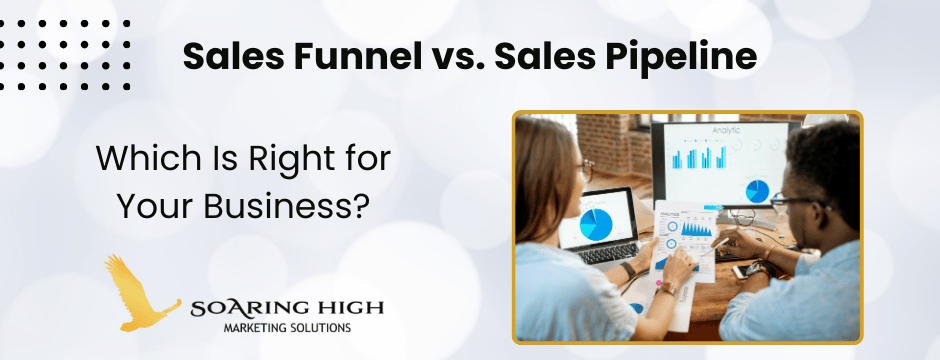When it comes to optimizing your sales process, knowing whether to use a sales funnel or a sales pipeline can make a world of difference. Both have their unique strengths and can significantly impact your business. Let’s dive into the details and help you decide which approach is right for your business.
Quick Answer: Sales Funnel vs. Sales Pipeline
The sales funnel is all about understanding your customer’s journey from the moment they hear about you until they decide to make a purchase. It’s great for tracking how people move from being curious visitors to paying customers.
The sales pipeline, on the other hand, focuses on the steps your sales team takes to close deals. It’s more about managing and tracking each individual deal through the sales process.
The Sales Funnel: Mapping the Customer Journey
Picture this: You’re a local bakery trying to attract more customers. The sales funnel helps you understand how someone goes from seeing your delicious cakes on Instagram to walking through your door and making a purchase.
At the top of the funnel, people become aware of your bakery. They might see your posts on social media or come across your website through a Google search. As they move down the funnel, their interest grows, and they start to consider your bakery for their next sweet craving. They might compare your cakes with others, check out reviews, or look at your menu. Finally, when they’re ready to satisfy their sweet tooth, they make the purchase.
Why is this important? Because knowing how people move through these stages lets you tailor your marketing efforts to guide them smoothly towards that final purchase. And it’s not just for bakeries. Whether you’re selling software, consulting services, or handmade jewelry, understanding your customer’s journey is crucial.
The Sales Pipeline: Tracking the Deal Progress
Now, let’s switch gears. Imagine you’re running a tech startup. You’ve got a sales team hustling to close deals with other businesses. The sales pipeline is your roadmap here. It’s all about the steps your sales team takes to move a deal from initial contact to closing.
Think of the pipeline as a series of steps: You start by identifying potential clients, then qualify them to see if they’re a good fit. Next, your team engages with these prospects, setting up meetings or demos to showcase your product. After that, you send a proposal and negotiate terms before finally closing the deal.
The beauty of the sales pipeline is its structure. It gives your sales team a clear path to follow, ensuring nothing falls through the cracks. You can track each deal’s progress, see where things might be stalling, and take action to keep things moving forward.
Which One Should You Choose?
Deciding between a sales funnel and a sales pipeline depends on your business model and goals. Here’s a simple way to think about it:
- If your focus is on understanding and optimizing the customer journey, go with a sales funnel.
- If you need a structured approach to managing and closing deals, a sales pipeline is the way to go.
Let’s Talk Real-World Examples
A boutique hotel decided to implement an automated sales funnel to streamline their booking process. By sending targeted emails and personalized offers, they guided potential guests from the awareness stage all the way to booking a room. The result? A 30% increase in direct bookings.
On the flip side, a health and wellness center used a sales pipeline to manage their client acquisition process. By clearly defining each step and using a CRM system to track progress, they were able to reduce the time it took to close new clients by 25%.
The Power of Automation
An automated sales funnel can be a game-changer. Imagine setting up a system that nurtures leads automatically, sending the right message at the right time based on where they are in the funnel. This not only saves time but also ensures a consistent experience for your prospects.
For example, an e-commerce store might use automation to send personalized emails to shoppers who abandoned their carts, offering them a discount to complete their purchase. This approach has been shown to recover up to 15% of abandoned carts, translating directly into increased sales.
Conclusion
In the debate of sales funnel vs sales pipeline, there’s no one-size-fits-all answer. It really comes down to your business’s specific needs and goals. If you’re looking to understand and optimize the journey your customers take, a sales funnel is your best bet. If you need a structured approach to manage your sales process, a sales pipeline will serve you well.
The key is to choose the approach that aligns with your business model and sales strategy. And remember, combining elements of both can often provide a comprehensive solution that addresses multiple facets of your sales process.
Partnering with experts who understand these methodologies can further enhance your success and ensure your business thrives in a competitive market. Whether you’re leaning towards a funnel or a pipeline, the goal is the same: converting prospects into loyal customers.
About Us
At Soaring High Marketing Solutions, we specialize in helping businesses optimize their sales and marketing strategies through innovative approaches like sales funnels and sales pipelines. Our team of experts is dedicated to driving sustainable growth and maximizing your ROI. Partner with us to achieve your sales and marketing goals and ensure your business stands out in a competitive market.
Contact Us
For inquiries or to learn more about our services, please reach out to us:
Phone: (786) 529-6324
Email: noel@soaringhigh.marketing

